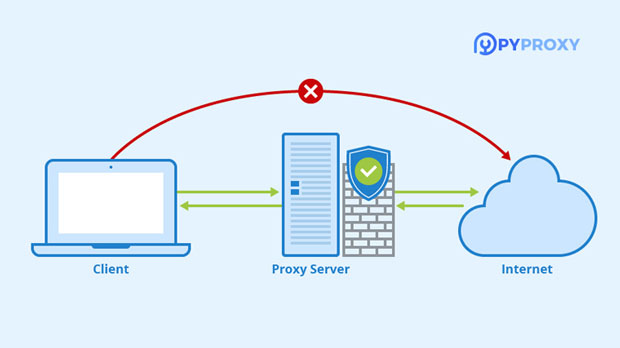In today's digital age, online privacy has become increasingly important. One effective method to protect your identity and secure your browsing activity is by using a proxy server. Proxy servers can mask your real IP address, making it appear as though your internet activity is coming from a different location. This can be useful for a variety of reasons, including bypassing geographic restrictions, avoiding tracking, or enhancing online security. In this article, we will dive into how proxy servers work, the benefits of using them, and how to effectively set them up to hide your true location. Understanding Proxy ServersA proxy server acts as an intermediary between your device and the websites you visit. When you send a request to access a website, the proxy server forwards that request on your behalf, retrieving the content from the internet. Instead of your device's IP address being exposed to the website, the proxy server's IP address is shown. This essentially hides your real IP and provides a layer of privacy.There are different types of proxy servers, including HTTP, HTTPS, SOCKS, and residential proxies. Each serves a different purpose and can be chosen based on the level of anonymity and security you need. For example, HTTP proxies are typically used for web browsing, while SOCKS proxies support a wider range of internet activities, such as file sharing and gaming.The Benefits of Hiding Your Real Location Using a Proxy Server1. Bypass Geographic Restrictions: Many websites or streaming services restrict access to content based on your location. By using a proxy server, you can make it appear as though you are accessing the internet from a different region, bypassing these restrictions.2. Maintain Online Privacy: When browsing the internet, your IP address can reveal a lot about your location and identity. A proxy server helps you maintain anonymity by masking your real IP address, preventing websites and online services from tracking your activities.3. Enhanced Security: A proxy server can add an extra layer of security by acting as a barrier between your device and the internet. It can also encrypt your internet traffic, making it more difficult for hackers to intercept your data.4. Access Blocked Content: If you are in a region where certain websites or social media platforms are blocked, using a proxy server allows you to circumvent these restrictions and access the content you need.How Proxy Servers Work to Hide Your Real IP AddressWhen you use a proxy server, the server takes over the task of connecting you to the internet. Your device sends a request to the proxy server, which then sends the request to the intended website. The website responds to the proxy server, and the server forwards the information back to you.Here’s how the process works in more detail:1. You connect to the proxy server: Your device sends a connection request to the proxy server, typically by configuring the device’s network settings.2. Request routing: Once the connection is established, any web request you make (like accessing a website) is routed through the proxy server.3. The proxy server sends the request: The proxy forwards your request to the website, appearing as though the request is coming from the proxy’s IP address.4. The website responds to the proxy: The website sends the requested data back to the proxy server, which then passes it to your device.5. You receive the data: You are able to access the website, but your real IP address remains hidden, and the website only sees the proxy server’s IP.Types of Proxy Servers and Their Use CasesThere are several types of proxy servers, each with its unique advantages. Choosing the right one for your needs depends on the level of anonymity and the specific tasks you want to perform.1. HTTP Proxy: This type of proxy is primarily used for web browsing. It intercepts HTTP requests and redirects them to the destination server. It is suitable for casual browsing but may not provide high security.2. HTTPS Proxy: Similar to HTTP proxies, but with the added benefit of encryption. HTTPS proxies are ideal for secure browsing, as they protect your data from being intercepted by third parties.3. SOCKS Proxy: SOCKS proxies work at a lower level of the internet protocol stack, allowing them to handle various types of internet traffic, such as email and peer-to-peer file sharing. SOCKS proxies are more versatile than HTTP and HTTPS proxies.4. residential proxy: These proxies use IP addresses assigned to real devices, making them harder to detect and block. Residential proxies are often used to avoid CAPTCHAs, bypass geographic restrictions, and perform large-scale web scraping.5. Transparent Proxy: Transparent proxies are typically used by organizations to monitor and filter internet traffic. They do not hide the real IP address but can still be useful for certain use cases like caching content to speed up browsing.Setting Up a Proxy Server to Hide Your IP AddressSetting up a proxy server is relatively straightforward, depending on the device and operating system you use. Here’s a general guide on how to set it up:1. Choose the Type of Proxy: First, decide which type of proxy server you want to use based on your needs. You may choose a free proxy or opt for a paid service for more security and reliability.2. Configure Your Device: In your device’s network settings, enter the IP address and port number of the proxy server. If you are using a web browser, you can also set up the proxy through the browser's settings.3. Verify the Proxy Connection: After configuring the proxy server, check whether your IP address is being masked by visiting an IP lookup website. If your real IP is not displayed, your proxy is working correctly.4. Test the Proxy Server: Make sure the proxy server is functioning properly by browsing different websites. You can test if the proxy is hiding your location by checking whether the server’s IP address is being displayed instead of your own.Potential Risks and Limitations of Using Proxy ServersWhile proxy servers can offer numerous benefits, there are some limitations and risks associated with their use:1. Reduced Speed: Since your internet traffic is routed through an additional server, it may result in slower browsing speeds.2. Security Risks: Some proxies, particularly free ones, may log your data or expose your information to third parties. It’s important to choose a trustworthy proxy server to maintain privacy and security.3. Limited Encryption: Some proxies, such as HTTP proxies, do not provide encryption, which means your data may be vulnerable to interception.4. Website Blocking: Some websites may detect and block traffic coming from proxy servers, especially if the proxy is used frequently for activities like web scraping.ConclusionProxy servers are a powerful tool to hide your real location and maintain privacy while browsing the internet. By routing your requests through a proxy server, you can mask your IP address and bypass geographical restrictions. Whether you want to enhance security, prevent tracking, or access blocked content, proxy servers offer a simple yet effective solution. However, it’s important to be aware of the potential risks, including slower browsing speeds and the possibility of security breaches. By selecting the right type of proxy and ensuring its proper configuration, you can take full advantage of this technology while safeguarding your online activities.
Jan 26, 2025





























































